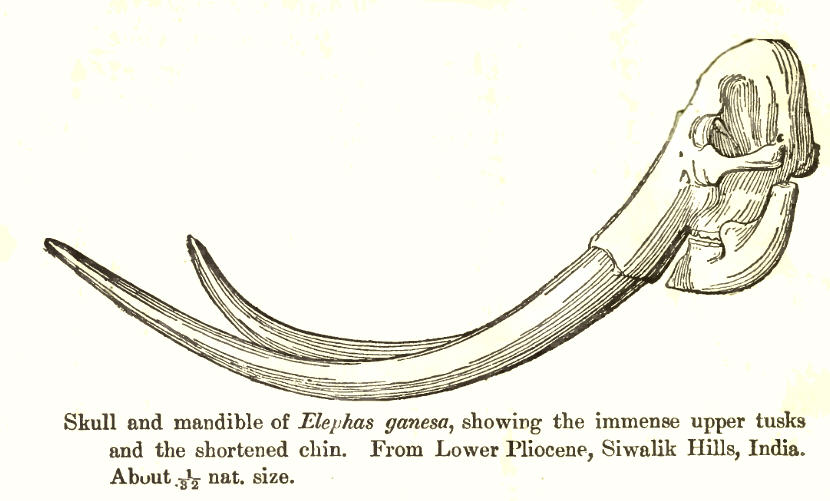- Stegodon
Taxobox
name = "Stegodon"
fossil_range =Pliocene -Pleistocene

regnum =Animal ia
phylum =Chordata
classis =Mammal ia
ordo =Proboscidea
familia =Elephantidae
subfamilia =Stegodontinae
genus = "Stegodon"
genus_authority = Falconer, 1847"Stegodon" is a
genus of theextinct subfamily Stegodontinae of the orderProboscidea . Stegodonts lived in large parts ofAsia during thePliocene andPleistocene epochs. Some "Stegodon" species were among the largest of all "Proboscidea", with adults being 13 feet high at the shoulder, 26 feet long, not including 10 feet long nearly straight tusks. In some individuals the tusks were so close together that the trunk probably did not lie between them but instead draped over. A dwarf population survived until 12,000 years ago on the Island ofFlores . A review of 130 papers written about 180 different sites with "Proboscidea" remains in southern China revealed "Stegodons" to have been more common than Asian Elephants; the papers gave many recent radiocarbon dates, the youngest being 2,150 B.C. (4,100 BP). [H. Saegusa, " [http://www.cq.rm.cnr.it/elephants2001/pdf/345_349.pdf Comparisons of Stegodon and Elephantid Abundances in the Late Pleistocene of Southern China] ", The World of Elephants -- Second International Congress, (Rome, 2001), 345-349. ] The name "Stegodon" is derived from the Greek words στεγειν "stegein" ('to cover') and οδον "odn" ('tooth ') because of the distinctive ridges on the animal's molars.Relationship
In the past, stegodonts were believed to be the
ancestor s of the trueelephant s andmammoth s, but it is currently believed that they have no modern descendants. "Stegodon" is derived from the genus "Stegolophodon ", an extinct genus known from the Miocene of Asia. "Stegodon" is considered to be a sister group of the mammoth, as well as the elephants. Some taxonomists consider the stegodonts as a subfamily of the Elephantidae. Both "Stegolophodon " and primitive elephants were derived from theGomphotheriidae . The most important difference between "Stegodon" and the Elephantidae can be observed in the molars. Molars of stegodonts consist of a series of low, roof-shaped ridges, whereas in elephants each ridge has become a high-crowned plate. Furthermore, the skeletons of stegodonts are more robust and compact than those of elephants.In the
Bardia National Park inNepal , there is a population of Indian Elephants which, due toinbreeding are very similar to "Stegodon" and may retain many "Stegodon" features. Some dismiss these primitive features as recentmutation s rather thanatavism s. [citeweb|title=Living Stegodont or Genetic Freak?|url=http://www.ncf.carleton.ca/~bz050/HomePage.gne.html|author=Ben S. Roesch|accessdate=2008-06-18]Dwarfing on islands
Like elephants, stegodonts must have been good swimmers. Their
fossil s are frequently encountered on Asian islands, which even during periods of low sea-level (during the cold phases of thePleistocene ) were not connected bylandbridge s with the Asian continent (Sulawesi ,Flores ,Timor ,Sumba inIndonesia ,Luzon andMindanao in thePhilippines and inTaiwan andJapan ). A generalevolutionary trend in large mammals on islands isisland dwarfing . The smallest dwarf species, "Stegodon sondaari ", known from 900,000 year old layers on the Indonesian island of Flores, had an estimated bodyweight comparable to a water buffalo. Another dwarf species lived on Flores more recently, and was contemporaneous with thehominin discovered in 2003, "Homo floresiensis ". "Stegodon tetrabelodon syrticus" was a spectacular late Miocene species with four tusks described from a partial cranium and jaws found in North Africa [ Turner, A: "Evolving Eden", page 119. Columbia University Press, 2004]There are twelve known species of "Stegodon":
*"Stegodon elephantoides" (
Myanmar , Java)
*"Stegodon sompoensis" (Sulawesi , Indonesia)
*"Stegodon aurorae" (Japan ) -Aurora's Stegodont
*"Stegodon ganesha" (India ,Pakistan )
*"Stegodon insignis" (Pakistan)
*"Stegodon zdanski" (China )
*"Stegodon orientalis" (China, Japan) -Oriental Stegodont
*"Stegodon shinshuensis" (Japan) -Japanese Stegodont
*"Stegodon trigonocephalus" (Java, Indonesia)
*"Stegodon sondaari" (Flores, Indonesia)
*"Stegodon tetrabelodon syrticus" (Shabi, Libya)
*"Stegodon florensis" (Flores, Indonesia)References
Wikimedia Foundation. 2010.
